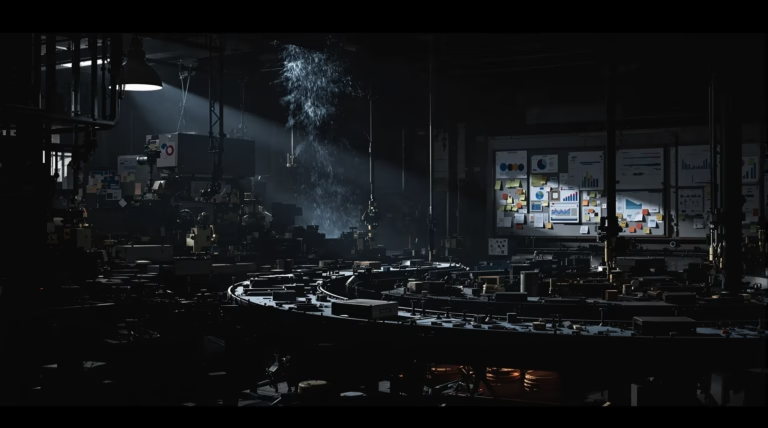Material Requirements Planning: A Comprehensive Guide to MRP
Looking to optimize your manufacturing operations and streamline inventory control? Material Requirements Planning (MRP) represents a transformative approach to production management that can revolutionize how your business handles resource allocation. Let’s explore this powerful system and its impact on modern manufacturing.
Understanding Material Requirements Planning (MRP)
Material Requirements Planning (MRP) is a production planning and inventory control system that optimizes manufacturing operations. This systematic approach ensures precise material availability while maintaining minimal inventory levels. Through data-driven decision-making, MRP analyzes demand for finished goods and calculates backward to determine component and raw material requirements.
- Optimizes resource allocation and timing
- Reduces waste and improves efficiency
- Enables quick response to market changes
- Provides data-driven precision in planning
- Maintains optimal inventory levels
The Evolution of MRP: From ROP to MRP II
The 1960s marked the emergence of MRP as a significant advancement over traditional Reorder Point (ROP) systems. While ROP relied on historical data, MRP introduced forward-looking planning based on actual production schedules and forecasted demand.
| Era | System | Key Features |
|---|---|---|
| 1960s | Original MRP | Basic material planning, forward-looking approach |
| 1980s | MRP II | Integrated financial planning, capacity planning, shop floor control |
| Present | Advanced MRP | AI integration, real-time analytics, adaptive planning |
Key Objectives and Functions of MRP
MRP’s primary focus lies in balancing manufacturing efficiency with effectiveness. The system processes critical calculations through a systematic approach:
- Determines gross material requirements from production schedules
- Calculates net requirements by considering current inventory
- Plans order releases based on lead times and constraints
- Generates exception reports for potential problems
- Provides dynamic planning adjustments
Components of MRP Systems
MRP systems integrate several components to create a comprehensive planning framework. These elements work in concert to transform raw data into actionable production plans, ensuring optimal inventory levels and timely material availability.
Bill of Materials (BOM) and Its Role in MRP
The Bill of Materials serves as the foundational blueprint of the MRP system. It provides a detailed breakdown of all components and materials needed for production, enabling:
- Precise component quantity calculations
- Hierarchical relationship mapping
- Distinction between independent and dependent demand
- Efficient engineering change management
- Accurate production scheduling
Master Production Schedule (MPS) Explained
The Master Production Schedule acts as the driving force behind MRP operations, translating business plans into specific manufacturing activities. It creates a detailed timeline that balances multiple factors:
- Customer order fulfillment
- Sales forecast integration
- Safety stock maintenance
- Production capacity optimization
- Resource deployment efficiency
Inventory Status File: Tracking Inventory Levels
The Inventory Status File functions as a real-time database that provides comprehensive visibility into all materials and components across the manufacturing environment. This critical system serves as the factual foundation for MRP decision-making by tracking:
- Current on-hand quantities
- Allocated amounts
- Items on order and expected receipt dates
- Lead times and safety stock levels
- Lot sizing rules and reorder points
When integrated with warehouse management systems, the inventory file delivers location-specific information and quality status tracking, ensuring only available, usable inventory factors into planning calculations. Advanced MRP systems maintain near real-time accuracy through continuous updates as transactions occur.
Advanced MRP Concepts: DDMRP and Beyond
Modern manufacturing environments demand more sophisticated planning approaches than traditional MRP systems. Advanced MRP concepts incorporate real-time data analytics, adaptive planning techniques, and demand-responsive mechanisms to create resilient production systems. This evolution represents a shift from forecast-driven push systems to market-responsive pull systems, enabling manufacturers to navigate supply chain disruptions while maintaining competitive advantages.
Demand-Driven MRP: A Modern Approach
Demand-Driven Material Requirements Planning (DDMRP) combines traditional MRP structure with lean manufacturing responsiveness. This innovative approach positions strategic inventory buffers throughout the supply chain based on actual customer demand signals.
- Strategic buffer positioning
- Buffer profiles and levels
- Dynamic adjustments
- Demand-driven planning
- Visible and collaborative execution
Organizations implementing DDMRP typically achieve service levels exceeding 97% while reducing inventory levels by 30-45%, proving particularly effective in industries with volatile demand patterns or complex supply chains.
Predictive MRP: Enhancing Planning Accuracy
Predictive MRP leverages advanced analytics, machine learning, and artificial intelligence to revolutionize planning accuracy. These sophisticated systems analyze:
- Historical data patterns
- Market trends
- Weather patterns
- Social media sentiment
- Supply chain variables
AI-powered systems can detect early warning signs of supply disruptions and automatically suggest mitigation strategies. Additionally, predictive maintenance capabilities align with production plans to anticipate equipment failures, creating a forward-looking planning environment that anticipates changes rather than merely reacting to them.
Challenges and Best Practices in MRP Implementation
| Challenge Area | Impact | Consideration |
|---|---|---|
| Data Management | System accuracy | Requires robust control systems |
| Organizational Resistance | Implementation success | Needs management support |
| Technical Complexity | Operation efficiency | Demands skilled personnel |
Successful implementation requires substantial investment in time, resources, and organizational commitment. Companies must evaluate their manufacturing processes, assess personnel capabilities, and secure management support to realize the full potential of their MRP systems while minimizing operational disruption.
Common Challenges in MRP Systems
Data integrity stands as the most critical challenge in MRP implementations, embodying the principle of ‘garbage in, garbage out.’ Even minor errors in inventory records, bills of materials (BOMs), or master production schedules can cascade throughout the system, leading to incorrect planning decisions.
- Unreported scrap and production reporting failures
- Receiving and shipping errors
- Cycle count adjustments
- Box count mistakes
- System reliability compromises
Lead time assumptions represent another significant hurdle for MRP systems. Organizations frequently base planning decisions on historical or theoretical lead times that fail to reflect actual production realities. Additionally, many companies struggle with organizational alignment issues, where departments operate in silos rather than collaborating toward system success. The challenge intensifies when organizations lack the technical expertise to properly configure and maintain sophisticated MRP systems.
Best Practices for Effective MRP Implementation
| Practice Area | Key Activities |
|---|---|
| Data Governance | BOM verification, physical validation, cycle count analysis |
| Inventory Management | Scrap reporting systems, dedicated collection points |
| Implementation Strategy | Phased approach, staff training programs |
| Performance Tracking | Inventory accuracy metrics, planning precision monitoring |
Beyond data management, organizations should adopt a phased implementation approach that allows for learning and adjustment. Cross-functional implementation teams including representatives from production, inventory management, purchasing, and IT ensure comprehensive perspective and organizational buy-in. Regular system audits and continuous improvement processes help organizations identify and address emerging issues before they impact performance.
Integrating MRP with ERP Systems
The integration of Material Requirements Planning (MRP) with Enterprise Resource Planning (ERP) systems represents a significant evolution in manufacturing technology. While MRP focuses specifically on production planning and inventory control, ERP systems offer a comprehensive framework that encompasses the entire business operation. This integration creates a seamless flow of information across departments, breaking down traditional silos between production, procurement, sales, and financial management.
The Role of ERP in Enhancing MRP Capabilities
- Unified data environment extending beyond manufacturing
- Real-time visibility into customer orders
- Advanced data integration and processing
- Sophisticated supply chain planning
- Comprehensive financial integration
ERP systems elevate MRP functionality through advanced data integration and processing capabilities. This integration facilitates more sophisticated supply chain planning by connecting internal production requirements with external supplier capabilities and constraints, resulting in a more agile manufacturing operation.
Benefits of MRP and ERP Integration
- Prevention of production delays through improved material availability
- Inventory reductions of 15-30%
- Enhanced service levels
- Improved resource utilization
- Comprehensive data visibility across the enterprise
The integration also enhances decision-making capabilities by providing comprehensive data visibility across the enterprise. Manufacturing executives can quickly assess how production decisions impact financial performance, customer satisfaction, and supply chain resilience, ultimately improving competitive positioning and business performance.







